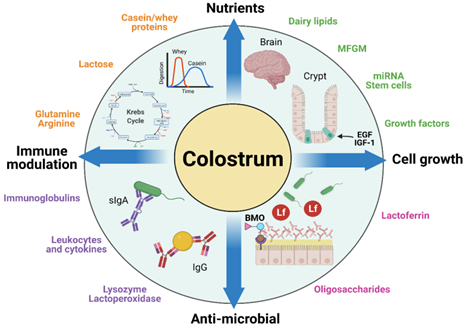Healthy Calf Conference
Follow to stay up-to-date on all Healthy Calf Conference updates. Speaker announcements, sponsorship information, registration announcements, and more.
By Lucía Pisoni, Ph.D1,2
1 Department of Animal Biosciences, University of Guelph
2 The Saskatoon Colostrum Company Ltd.
The neonatal period represents a critical window for calves’ health, development, and future productivity. In this context, colostrum emerges as a vital tool, not only for its immediate immunological function, but also for its ability to modulate key physiological processes through early developmental programming.
Colostrum is the sole source of passive immunity, energy, and essential bioactive compounds for the newborn calf (Poonia & Shiva, 2022). Its value extends beyond immunity, and colostrum is now recognized as a programming agent capable of inducing long-term physiological and metabolic adaptations that shape the adult phenotype. This phenomenon of early life programming has gained relevance in scientific literature due to its impact on resilience, growth, and the ability to respond to stress (Patel & Srinivasan, 2002; Scheffer et al., 2018).
Supporting this concept, the “lactocrine” hypothesis proposes that milk-borne factors in colostrum can induce epigenetic modifications through nutrition, potentially leading to lasting effects on calf performance and long-term productivity (Soberon et al., 2012). Several studies have shown that calves that receive high-quality colostrum in sufficient quantity soon after birth show lower disease rates, improved reproductive performance, and higher milk production later in life (Faber et al., 2005; DeNise et al., 1989). In contrast, failures in the transfer of passive immunity and poor colostrum management are associated with substantial health and economic losses (Lombard et al., 2020; Crannell & Abuelo, 2023).
Colostrum contains high concentrations of immunoglobulins (mainly IgG), colostral fat, vitamins, minerals, specific proteins, and growth hormones, all of which possess antimicrobial and immunomodulatory properties that influence early development (Poonia & Shiva, 2022; Sangild et al., 2021).
Colostral fat provides approximately 50 per cent of the total energy intake in the neonatal diet and plays a critical role in thermoregulation during the first days of life (Godden, 2008). A deficiency of colostral fat can lead to energy deficits, hypothermia, and decreased calf viability.
There are some differences regarding fat composition between milk and colostrum. Previous studies have reported higher proportions of n-3 and n-6 polyunsaturated fatty acids (PUFAs) in colostrum compared to mature milk (Contarini et al, 2014; Wilms et al., 2022). These essential fatty acids act as precursors for eicosanoids, bioactive lipid mediators involved in inflammatory responses, thereby supporting the calf’s physiological adaptation from the intrauterine to the extrauterine environment.

Colostrum also contains a wide range of bioactive compounds such as lactoferrin, oligosaccharides, growth hormones, and insulin, among others, which promote intestinal mucosa maturation, villi development, and, as a result, expansion of the absorptive surface (Figure 1; Blum and Hammon, 2000; Ontsouka et al., 2016; Sangild et al., 2021). These effects lead to improved nutrient absorption that translates into greater feed efficiency and growth.
Colostrum oligosaccharides support beneficial microbial populations while preventing pathogen adhesion to the gut lining (Fischer-Tlustos et al., 2020). Recent studies show that oligosaccharides present in colostrum and early milkings promote the growth of beneficial bacteria like Bifidobacterium and Lactobacillus, while inhibiting pathogens such as E. coli K99 (Fischer-Tlustos et al., 2020). This early prebiotic effect enhances gastrointestinal health and strengthens mucosal immunity.
Another key component of colostrum is lactoferrin, a glycoprotein with potent antimicrobial, anti-inflammatory, and immunomodulatory properties. By sequestering free iron, it inhibits pathogenic bacteria and simultaneously supports intestinal development and immune regulation (Sangild et al., 2021).
Other bioactive components such as insulin-like growth factor 1 (IGF-1), insulin, and growth hormones bind to specific receptors on the intestinal epithelium, promoting cell proliferation and differentiation, villi elongation, and the expansion of the absorptive surface (Ontsouka et al., 2016; Roffler et al., 2003). Altogether, these compounds not only complement the immunological value of colostrum but also enhance its benefits through complex physiological mechanisms.
Colostrum is one of the most powerful yet underestimated tools in calf rearing. When delivered at the right time, in sufficient quantity and quality, it not only ensures effective transfer of passive immunity but also acts as a physiological development programmer, producing lasting benefits throughout the animal’s productive life.
The scientific evidence is clear: proper colostrum management reduces neonatal morbidity and mortality (Crannell & Abuelo, 2023; Shivley et al., 2018), improves growth rates and feed efficiency (Soberon et al., 2012), and is linked to better reproductive performance and higher milk yields in early lactations (Faber et al., 2005; DeNise et al., 1989).
Efficient colostrum management is a simple, cost-effective, and high-impact intervention. At its core, it is a preventive measure that can redefine the productive future of every calf. Recognizing its importance demands a long-term perspective grounded in scientific evidence, with a dual focus on animal welfare and the overall efficiency of the dairy system.
References available upon request.
Follow to stay up-to-date on all Healthy Calf Conference updates. Speaker announcements, sponsorship information, registration announcements, and more.
The Codes of Practice are nationally developed guidelines for the care and handling of farm animals. They serve as our national understanding of animal care requirements and recommended practices.